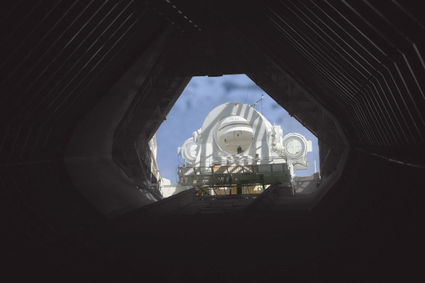Tuscon Trek
Sky Watch: Keeping an eye above the horizon

Lauren Hollen
"Looking up the 500-foot barrel of Kitt Peak's McMath-Pierce Solar Telescope is truly awesome!"
This column is about aerospace happenings in and around Tehachapi. I'm going to stretch that definition and tell you about a marvelous trip to Tucson, Ariz. If you don't mind driving ten hours at a stretch, you can get there in a day. I chose to go by train: Metrolink from Lancaster to Union Station, and Amtrak will get you there at dawn. The 24/7 party at the Congress Hotel across from the train station will probably still be going strong. (Complementary earplugs are available for hotel guests.)
Tucson is something of an "astronomy Mecca." Its crystal clear skies and relatively temperate weather make it one of the finer dark sky sites in the nation. The crown jewel of Tucson observatories is owned by all of us: Kitt Peak National Observatory. Construction began in the late 1950s as part of the worldwide upsurge in fascination with the cosmos. Today the observatory has grown to total of 24 optical and two radio telescopes and is considered the largest and most diverse gathering of astronomical instruments in the world. It includes the largest solar telescope in the world and now has three telescopes that are larger than Mount Palomar's famous 200-inch Hale Telescope. The observatory has scheduled daytime tours and nighttime star parties.
The observatory is situated within the lands of the Tohono O'odham Indian Nation, which the United States leases by treaty in perpetuity. The tribe is proud to support the work of the observatory, and the observatory is proud to support the causes of the tribe.
Another amazing facility is the University of Arizona's Stewart Observatory Mirror Lab. Located under the football stadium, this unlikely factory turns out the mirrors for the largest telescopes in the world. Their current projects include the Large Synoptic Survey Telescope that will take time-lapse photos of the entire sky twice-a-week. I wish space allowed me to go into the details of how they make these engineering marvels. One thing: Their glass chunk supplier is in Japan; not because they're cheaper (they're not!), but because no one else in the world will even try to make glass so perfectly. Think Samurai sword!
Their most ambitious project is the Giant Magellan Telescope (GMT), which will combine seven mirrors into a massive 22-meter instrument. The great Hale Telescope on Mount Palomar would be merely an oversized finder scope for this behemoth! Each of GMTs seven 8.4-meter (27.6 feet!) mirrors takes seven years to make. The Mirror Lab has ambitious plans to get it down to three years (but they don't seem sanguine about achieving that).
The GMT will have ten times the resolving power of the Hubble Space Telescope. Each of its seven giant mirrors will weigh over ten tons, yet will be held steady to an unthinkable tolerance. Mirror one was completed in late 2012. Mirrors two and three are in process, and mirror four will be started later this year. Completion is targeted for 2019. Let's hope Hubble can hang in there that long.
Tours of the Mirror Lab are available by reservation through mirrorlab.as.arizona.edu/tours.
The third unique aerospace facility I visited had a special interest to me: The Titan Missile Museum. The area south of Tucson was a major missile base of the Cold War. All have been decommissioned, but one has been left intact – by treaty – so that the high-stakes game we were playing would never be forgotten.
To me this was the 'flip-side' of the Cold War, for I served as a Polaris Missile submariner in the 1970s. While these Air Force airmen were threatening to rain down megatons of hell from Tucson, we were threatening to launch megatons from beneath the waves. I'm convinced that us submariners got the better end of the deal. We had better food and more interesting routines; not only did we drill to unleash Armageddon and spend endless hours babying our missiles, we still had to be sailors. We played war games hunting and killing aircraft carriers, and even got to launch a few of our missiles now and then (how cool is that!). Those poor Air Force guys (and in the end a few gals) had little new to look forward to when it was time to "go to the office." We even got paid more because of the "hazardous duty," but I think boredom can be just as hazardous. As for the claustrophobia that most people mention when the subject of submarines comes up–well, it wasn't much more spacious down in that Titan missile silo.
Tucson really is an aerospace mini-vacation worth taking one day!
In 1980, Dr. Carl Sagan launched what was arguably the most enlightening miniseries in television history. Thirty-four years later, his widow and co-writer of that series, Ann Druyan, has teamed up with renowned astronomer Dr. Neil Tyson to do it all over again. Old-timers can get up to date on the latest and youngsters can get up to speed on humanities latest accomplishments in our endeavor to understand ourselves and the Universe we inhabit. As Dr. Sagan put it so well, "We are a way for the Universe to understand itself." What a marvelous gift! Check it out on Sundays at 9 p.m. on FOX or Mondays at 6 or 10 p.m. on the National Geographic Channel.
There will be a total eclipse of the moon on the night of April 14 to 15. The moon will begin to darken at about 10:30 p.m. and will be completely within the earth's shadow at around midnight.
Sunrise/Sunset (Apr. 1) 6:40 a.m./7:16 p.m.




